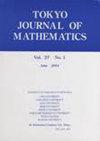Lucas序列的几何方面,I
IF 0.4
4区 数学
Q4 MATHEMATICS
引用次数: 4
摘要
我们提出了一种在群方案理论的框架下看待Lucas序列的方法。这使我们能够从几何和函数的角度来处理Lucas序列,这是Laxton⟨关于线性递归组I⟩和Aoki-Sakai \10216提出的二阶线性递归序列的Mod p等价类。引言Lucas序列,包括Fibonacci序列,已经被广泛研究了很长一段时间,并且留下了巨大的研究积累。尤其是可分性问题是Lucas序列研究的一个主要课题。更明确地说,设P和Q是非零整数,设(wk)k≥0是线性递推关系wk+2=Pwk+1-Qwk与初始项w0,w1∈Z定义的序列。如果w0=0和w1=1,则(wk。整除性问题要求描述一个正整数m的集合{k∈N;wk lect 0 mod m}。Edouard Lucas[6]肯定地提出了第一步,即在m是素数且(wk)k≥0是Lucas序列的情况下的幻影和重复定律,此后出现了各种各样的结果。本文从几何的角度研究了Lucas序列的可分性问题,将Lucas序列上的一些描述转化为仿射群方案的语言。例如,幻影和重复定律在我们的上下文中被公式化如下:定理(=命题3.23+定理3.25)设P和Q是非零整数,其中(P,Q)=1,设w0,w1∈Z,其中(w0,w1)=1。通过具有初始项w0和w1的递推关系wk+2=Pwk+1−Qwk定义序列(wk)k≥0,并放入μ=ordp(w1−Pwww1+Qw0)。设p为奇素数,其中(p,Q)=1,n为正整数。然后我们得到了轨道的长度(w0:w1)Θ在P(Z/pZ)=1(n≤μ)r(pn-μ)(n>μ)。此外,在P1(Z/pnZ)中存在k≥0使得wk≠0 mod pn当且仅当(w0:w1)∈(0:1)。这里,θ表示由β(θ)=(p/4Q,1/4Q)生成的G(D)(Z(p))的子群,r(pΓ)表示与(p,Q)相关的Lucas序列的秩mod pΓ。*)部分科研资助项目:No.2640024 2010数学学科分类小学13B05;次级14L15、12G05。1.本文章由计算机程序翻译,如有差异,请以英文原文为准。
Geometric Aspects of Lucas Sequences, I
We present a way of viewing Lucas sequences in the framework of group scheme theory. This enables us to treat the Lucas sequences from a geometric and functorial viewpoint, which was suggested by Laxton ⟨On groups of linear recurrences, I⟩ and by Aoki-Sakai ⟨Mod p equivalence classes of linear recurrence sequences of degree two⟩. Introduction The Lucas sequences, including the Fibonacci sequence, have been studied widely for a long time, and there is left an enormous accumulation of research. Particularly the divisibility problem is a main subject in the study on Lucas sequences. More explicitly, let P and Q be non-zero integers, and let (wk)k≥0 be the sequence defined by the linear recurrence relation wk+2 = Pwk+1 −Qwk with the intial terms w0, w1 ∈ Z. If w0 = 0 and w1 = 1, then (wk)k≥0 is nothing but the Lucas sequnces (Lk)k≥0 associated to (P,Q). The divisibility problem asks to describe the set {k ∈ N ; wk ≡ 0 mod m} for a positive integer m. The first step was certainly taken forward by Edouard Lucas [6] as the laws of apparition and repetition in the case where m is a prime number and (wk)k≥0 is the Lucas sequence, and there have been piled up various kinds of results after then. In this article we study the divisibility problem for Lucas sequences from a geometirc viewpoint, translating several descriptions on Lucas sequences into the language of affine group schemes. For example, the laws of apparition and repetition is formulated in our context as follows: Theorem(=Proposition 3.23+Theorem 3.25) Let P and Q be non-zero integers with (P,Q) = 1, and let w0, w1 ∈ Z with (w0, w1) = 1. Define the sequence (wk)k≥0 by the recurrence relation wk+2 = Pwk+1−Qwk with initial terms w0 and w1, and put μ = ordp(w 1−Pw0w1+Qw 0). Let p be an odd prime with (p,Q) = 1 and n a positive integer. Then we have the length of the orbit (w0 : w1)Θ in P(Z/pZ) = 1 (n ≤ μ) r(pn−μ) (n > μ) . Furthermore, there exists k ≥ 0 such that wk ≡ 0 mod pn if and only if (w0 : w1) ∈ (0 : 1).Θ in P1(Z/pnZ). Here Θ denotes the subgroup of G(D)(Z(p)) generated by β(θ) = (P/4Q, 1/4Q), and r(pν) denotes the rank mod pν of the Lucas sequence associated to (P,Q). ∗) Partially supported by Grant-in-Aid for Scientific Research No.26400024 2010 Mathematics Subject Classification Primary 13B05; Secondary 14L15, 12G05. 1
求助全文
通过发布文献求助,成功后即可免费获取论文全文。
去求助
来源期刊

Tokyo Journal of Mathematics
MATHEMATICS-
CiteScore
0.70
自引率
16.70%
发文量
27
审稿时长
>12 weeks
期刊介绍:
The Tokyo Journal of Mathematics was founded in 1978 with the financial support of six institutions in the Tokyo area: Gakushuin University, Keio University, Sophia University, Tokyo Metropolitan University, Tsuda College, and Waseda University. In 2000 Chuo University and Meiji University, in 2005 Tokai University, and in 2013 Tokyo University of Science, joined as supporting institutions.
 求助内容:
求助内容: 应助结果提醒方式:
应助结果提醒方式:


